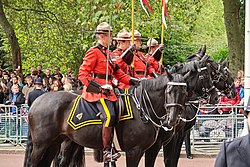


Mounted police are police who patrol on horseback or camelback. Their day-to-day function is typically picturesque or ceremonial, but they are also employed in crowd control because of their mobile mass and height advantage and increasingly in the UK for crime prevention and high visibility policing roles. The added height and visibility that the horses give their riders allows officers to observe a wider area, and it also allows people in the wider area to see the officers, which helps deter crime and helps people find officers when they need them. [1] When employed for crowd control, there is a risk that some people may be trampled (resulting in injuries or death). The officer riding the horse may be held legally responsible for injuries depending upon the totality of the circumstances. [2]
Contents
- History
- Equipment
- Notable modern units
- Australia
- Canada
- United Kingdom
- United States
- See also
- References
Mounted police may be employed for specialized duties ranging from patrol of parks and wilderness areas to riot. For example, in the UK, mounted police are most often seen at football matches. Some mounted police units are trained in search and rescue due to the horse's ability to travel where vehicles cannot.






